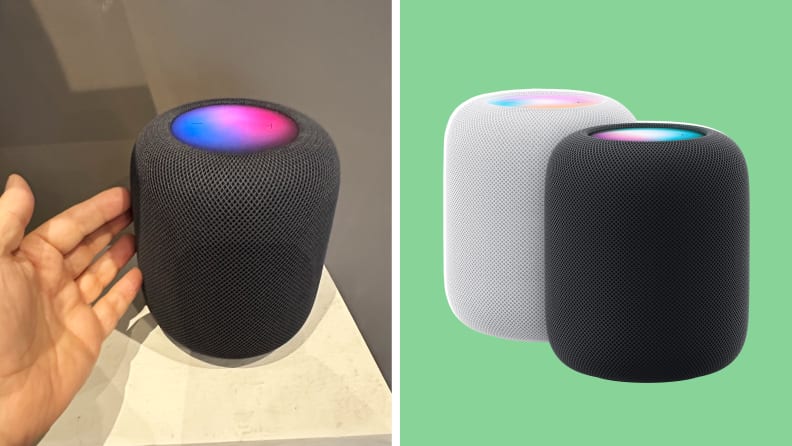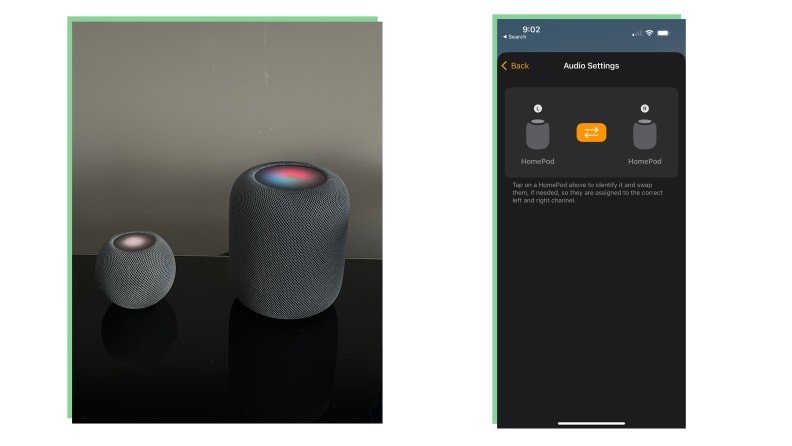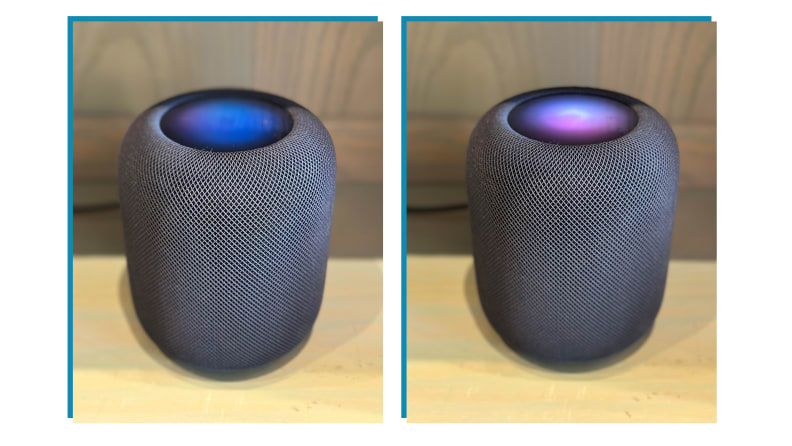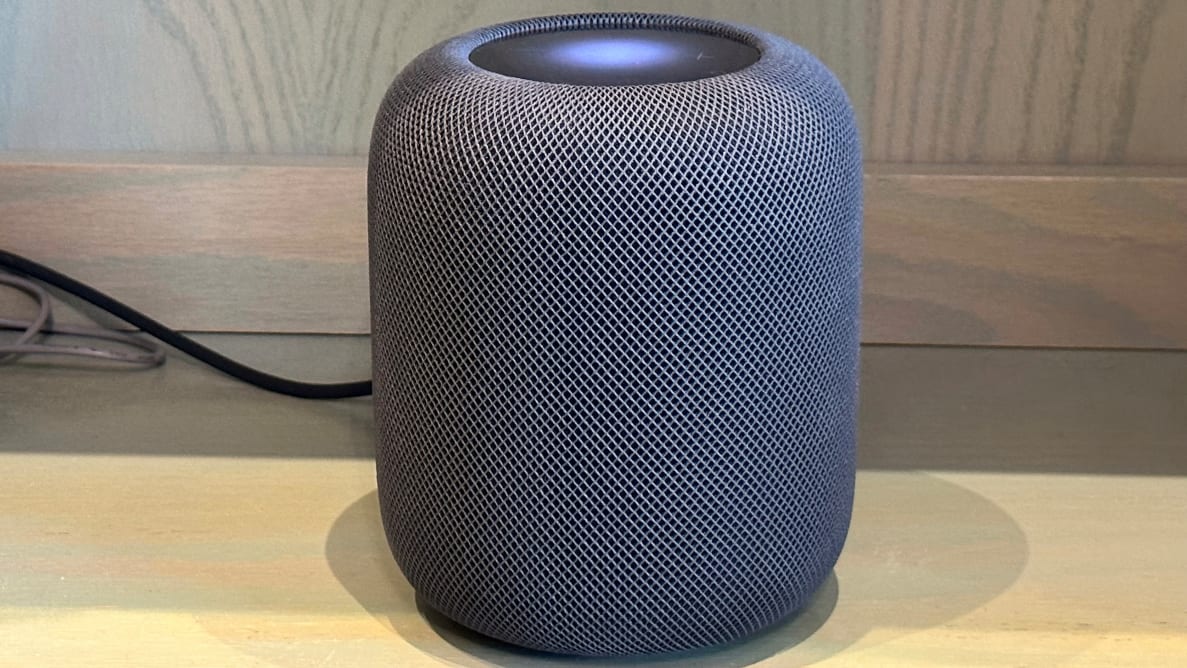Pros
-
Well-balanced audio
-
Temperature and humidity sensors
-
Matter compatible
Cons
-
Only works with iOS devices
About the Apple HomePod (second-gen)

The HomePod's woven fabric covering is available in both Midnight (Black) or White.
- Colors: Midnight, White
- Connectivity: 802.11n Wi-Fi, AirPlay, Bluetooth 5, Thread/Matter
- Smart assistant support: Google Assistant
- Weight: 5.16 lbs
- Dimensions: 6.6" H x 5.6" W x 5.6" D
HomePod houses a mesh fabric material, made with 100% recycled fabric, and includes a matching woven power cable. Unlike the first-gen HomePod (and HomePod Mini), the power cord is detachable.
Setup was a breeze, so long as you're on an iPhone. Plug in the HomePod and bring your iPhone close for it to recognize the speaker. Tap the iPhone screen to launch the setup. It took two minutes. Like many other Apple products, such as pairing AirPods, it's like magic.
On top of HomePod is a backlit touch surface that can be used to control tracks, such as Tap (play/pause), Double-tap (skip), Triple-tap (skip back), Touch and hold (activate Siri), and + and – icons for volume up or down, respectively.
What we like
The speaker has big, beautiful sound

The HomePod can stream music from a collection of apps, including Apple Music, Deezer, and Pandora.
Apple's big HomePod is back, and it sounds divine. Whether you set up a single speaker or a pair (and enable stereo mode for distinct left and right channels), HomePod delivers a rich acoustic soundscape that fills a room, especially when playing Apple Music tracks with lossless streaming or 360-degree Spatial Audio, and is complimented by well-balanced highs, mids, and lows. The speaker can natively play tunes from Apple Music, Deezer, and Pandora, but not Spotify (you’ll need AirPlay for that). It's on by default, but you can disable the extra bass via the Home app on iPhone.
Along with its long-throw 4-inch woofer for low frequencies, there are fewer tweeters than its similar-looking predecessor (five instead of seven) but are angled slightly upward for optimized delivery, along with beamforming calibration tech that bounces audio around the room to sense surfaces and deliver a more balanced experience.
Four microphones are listening to your Siri commands—even from across the room. Replacing the older A8 chip is the new S7 chip, to handle the processing. There wasn't an issue with Siri hearing or obeying spoken commands, even when playing loud music (such as asking "Siri, who sings this?").
It’s a better fit for smart homes than the previous generation
A better fit into your smart home than the original, the second-gen HomePod incorporates Matter, a connected home protocol that promises better compatibility and security than other platforms.
A nice-to-have but not need-to-have feature, HomePod also has built-in temperature and humidity sensors that can work with other smart devices in your home, like a smart thermostat, and adjust the temperature automatically if it falls below or climbs above a desired setting. On a related note, Apple says an upcoming software update (Spring 2023) will allow HomePod's microphones to listen for smoke or carbon monoxide alarms and notify you if it hears anything (via your iPhone).
The speaker can also be used with Apple’s Find My iPhone feature, so you can call out to Siri and easily locate your misplaced device at home. And, if you have multiple second-gen HomePod speakers, you can use them as intercoms, allowing you to communicate from one speaker to another in different rooms.
Streaming audio from one source to the speaker is a walk in the park

Two second-gen HomePods can be used as a stereo pair.
Using AirPlay, it was simple to stream audio from another source, too, including iPad, Mac, and Apple TV 4K (yes, you can use a pair of HomePods as a stereo soundbar, of sorts, while watching TV shows and movies). With ultra wideband support, you can also "hand off" an iPhone call, podcast, or song, to HomePod. It takes a couple of seconds to kick in but works flawlessly. Streaming audio to HomePod from apps like Spotify and VLC, via AirPlay, worked well, too.
What we don’t like
It doesn’t work with Android devices
Even though HomePod has Bluetooth support, it only extends to Apple devices. I tried pairing an Android device (specifically, a Samsung Galaxy S22 Ultra) and it could not find the speaker. Apple later confirmed HomePod will not work with Android. In other words, if you're not invested in the Apple ecosystem, there is no need to buy HomePod. A speaker like the Google Nest Audio or Amazon Echo is a better fit for Android users.
The new HomePod can’t handle as many commands as other smart speakers
I like Siri, but this personal assistant can't handle as many commands and questions as Google Assistant can (nor does it have the third-party Skill support that Amazon's Alexa enjoys). Having a Google Home Max speaker in my home office for the past few years, I started to ask Siri, via HomePod, some of the same requests, and Siri would politely tell you it can't help you on several of those requests. (In Apple's defense, Siri trades some functionality for your data privacy).
As a speaker, though, HomePod sounds better, and Siri has no trouble with your music-related queries. Not tested for this review, but Apple says Siri on the new HomePod can recognize up to six different voices and provide personalized responses and playlists.
It doesn’t work as a stereo pair with the first-gen HomePod or HomePod Mini

While the second-gen HomePod and HomePod Mini are visually complementary, they won't work as a stereo pair.
If you still have the first-generation Apple HomePod and are hoping to be able to use it as a stereo pair with the second-gen version, you’re out of luck. The two are not compatible for use with the stereo pairing feature. It’s also worth mentioning that, like the previous generation, there is no auxiliary hookup. The new HomePod also doesn’t work for stereo pair with the HomePod Mini, so you really need to invest in two of these new Apple speakers if you want to create more depth to your audio.
Privacy
Like the HomePod Mini, the second-gen HomePod speaker does not have a mic mute button on the top. This is a feature you will find on other smart speakers, like Amazon Echo devices. The touch controls at the top light up when Siri is activated, giving you a visual cue that the speaker is listening in. Apple says that Siri does not listen to what is being said unless spoken to directly.
Should you buy the Apple HomePod (second-gen)?
Yes, if you're an iPhone user who takes music seriously.

The second generation HomePod delivers excellent sound and features to make any Apple fan happy.
Along with extremely fast and simple setup, the second-gen Apple HomePod offers big sound, even filling up larger rooms, and best takes advantage of Apple Music's 100 million song catalog, lossless music streaming, and Spatial Audio support (for those who like that feature).
At $299 (or just shy of $600 for a pair of bookshelf speakers), the Apple HomePod is not cheap. Though it’s worth noting that the second-gen HomePod is priced $50 below the original HomePod ($349). While not as loud, and with many of the same features, the HomePod Mini, at $99 apiece, might be more attractive to some. Premium Google and Amazon smart speakers cost a lot less, too, and with a smarter assistant (especially Google), and natively supports Android devices. Plus, other third-party smart speakers—including top-rated Reviewed models like the Bose Home Speaker 300 and Sonos One—also cost less than the new HomePod.
But music fanatics invested in the Apple ecosystem won't be disappointed with this super impressive hardware.
The product experts at Reviewed have all your shopping needs covered. Follow Reviewed on Facebook, Twitter, Instagram, TikTok, or Flipboard for the latest deals, product reviews, and more. Prices were accurate at the time this article was published but may change over time.
Meet the tester
Along with Reviewed and USA TODAY, Marc has been a freelance journalist for more than 20 publications, is a 16-time author (including Apple Watch For Dummies and Game Design: Secrets of the Sages), hosts the syndicated Tech It Out radio (and podcast), and is host of Tech Impact television show (on Bloomberg TV and FOX Business). Based in Toronto, Marc specializes in consumer electronics, games and apps, smart home innovations, automotive tech, and future trends.
Checking our work.
Our team is here to help you buy the best stuff and love what you own. Our writers, editors, and experts obsess over the products we cover to make sure you're confident and satisfied. Have a different opinion about something we recommend? Email us and we'll compare notes.
Shoot us an email


